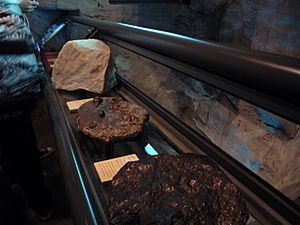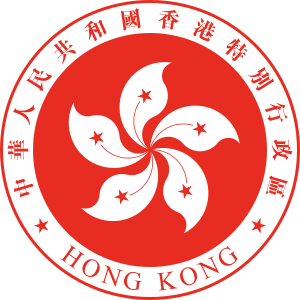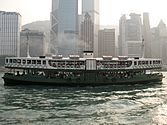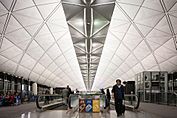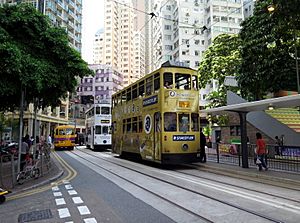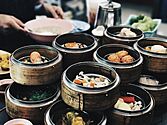Hong Kong facts for kids
Quick facts for kids
Hong Kong
香港
|
|||||||
|---|---|---|---|---|---|---|---|
|
Special administrative region
|
|||||||
| Hong Kong Special Administrative Region of the People's Republic of China
Other official names
|
|||||||
|
|||||||
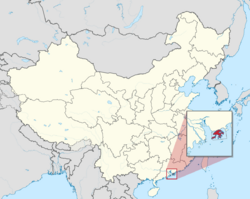
Location of Hong Kong within China
|
|||||||
| Sovereign state | China | ||||||
| British possession | 26 January 1841 | ||||||
| Treaty of Nanking | 29 August 1842 | ||||||
| Convention of Peking | 24 October 1860 | ||||||
| New Territories lease | 9 June 1898 | ||||||
| Imperial Japanese occupation | 25 December 1941 to 30 August 1945 | ||||||
| Redesignated as a British Dependent Territory | 1 January 1981 | ||||||
| Sino-British Joint Declaration | 19 December 1984 | ||||||
| Handover to China | 1 July 1997 | ||||||
| Administrative centre | Tamar | ||||||
| Largest district by population |
Sha Tin | ||||||
| Official languages |
|
||||||
| Cantonese | |||||||
|
Official scripts
|
Traditional Chinese English alphabet |
||||||
| Ethnic groups
(2021)
|
91.6% Chinese 2.7% Filipino 1.9% Indonesian 0.8% White 0.6% Indian 0.4% Nepalese 2% other |
||||||
| Demonym(s) | Hongkonger Hongkongese |
||||||
| Government | Devolved executive-led government within a unitary one-party state | ||||||
|
• Chief Executive
|
John Lee | ||||||
|
• Chief Secretary
|
Eric Chan | ||||||
|
• Council President
|
Andrew Leung | ||||||
|
• Chief Justice
|
Andrew Cheung | ||||||
| Legislature | Legislative Council | ||||||
| National representation | |||||||
| 36 deputies | |||||||
| 203 delegates | |||||||
| Area | |||||||
|
• Total
|
2,754.97 km2 (1,063.70 sq mi) (168th) | ||||||
|
• Water (%)
|
59.70% (1,640.62 km2; 633.45 sq mi) |
||||||
|
• Land
|
1,114.35 km2 (430.25 sq mi) |
||||||
| Highest elevation
(Tai Mo Shan)
|
957 m (3,140 ft) | ||||||
| Lowest elevation | 0 m (0 ft) | ||||||
| Population | |||||||
|
• 2023 estimate
|
|||||||
|
• 2021 census
|
|||||||
|
• Density
|
6,801/km2 (17,614.5/sq mi) (4th) | ||||||
| GDP (PPP) | 2023 estimate | ||||||
|
• Total
|
|||||||
|
• Per capita
|
|||||||
| GDP (nominal) | 2023 estimate | ||||||
|
• Total
|
|||||||
|
• Per capita
|
|||||||
| Gini (2016) | ▲ 53.9 high |
||||||
| HDI (2022) | very high · 4th |
||||||
| Currency | Hong Kong dollar (HK$) (HKD) | ||||||
| Time zone | UTC+08:00 (HKT) | ||||||
| Date format | dd/mm/yyyy yyyy年mm月dd日 |
||||||
| Mains electricity | 220 V–50 Hz | ||||||
| Driving side | left | ||||||
| Calling code | +852 | ||||||
| ISO 3166 code |
|
||||||
| Internet TLD | |||||||
| Number plate prefixes | None for local vehicles, 粤Z for cross-boundary vehicles | ||||||
Hong Kong (which means "Fragrant Port" in Chinese) is a special region in China. It is one of the richest and most developed places in China and the world. Hong Kong grew very fast after World War II. Today, it is a famous global financial center.
More than seven million people live in Hong Kong. Its economy has changed from a trading port to a very rich city.
Hong Kong is made up of 3 main parts:
- Hong Kong Island
- Kowloon
- New Territories (this includes 235 smaller islands)
Hong Kong was a British colony from 1842 to 1997. This happened after China lost the Second Opium War. After the handover in 1997, Hong Kong became part of China.
Contents
Hong Kong's Weather
Hong Kong is in a warm, wet area. It has monsoon winds. Winters (January-March) are cool and wet. Spring and summer (April-September) are hot and rainy. Autumn (October-December) is warm, sunny, and dry. The rainy season is from May to September. In summer and early autumn, Hong Kong often gets typhoons.
People and Languages
In 2009, Hong Kong's population reached 7 million people. Most people in Hong Kong are Chinese. Hong Kong is one of the most crowded places in the world. About 6,300 people live in each square kilometer.
Hong Kong has one of the lowest birth rates in the world. In 2012, it was 1.11 births per woman. This is much lower than the 2.1 rate needed for the population to stay the same.
People in Hong Kong mainly speak Cantonese. Many also learn English. Since Hong Kong became part of China, more people speak Mandarin. Mandarin is the official language of China. Some schools teach subjects in different languages. This depends on what language students are most comfortable with.
Money in Hong Kong
Hong Kong uses the Hong Kong dollar. There are coins from 10 cents to 10 Hong Kong dollars. Paper money bills range from $10 to $1000. One American dollar is worth about $7.75 Hong Kong dollars. This is the official bank exchange rate.
Hong Kong's History
Here is a short history of Hong Kong:
Around 4000 BC
- Sea levels rose more than 100 meters.
Around 3500 BC
- People made ceramic items with many patterns.
Around 2000 BC
- People used bronze weapons, knives, and tools.
- Metal was worked in the area.
Around 500 BC
- Ancient Chinese writing began to develop.
221 BC
- People from mainland China came to Hong Kong.
220 AD
- Coins from the Han period were used in Hong Kong.
1555
- A Portuguese explorer named Jorge Álvares was the first European to reach Hong Kong.
1799
- The sale of opium became very successful.
1839
- Lin Zexu was sent as a special commissioner.
- The First Opium War began.
1841
- Hong Kong was given to the British. It became a dependent territory of the United Kingdom.
- Lord Palmerston said Hong Kong was just a barren island.
January 26, 1841
- The British flag was raised at Possession Point on Hong Kong Island.
August 1841
- Sir Henry Pottinger became Hong Kong's first governor.
- China and Britain signed the Treaty of Nanjing. This ended the First Opium War.
1860
- China lost another Opium War. Boundary Street and Stonecutter's Island were leased to Britain.
1888
- The Peak Tram on Hong Kong Island started running.
1898
- Lantau Island and the New Territories were leased to the British for 99 years.
1900s
- Hong Kong became a safe place for people leaving China.
1920s-1930s
- Western clothing became popular for local people.
1933-1934
- Father Daniel Finn started digging on Lamma Island.
1941
- Many people moved to Hong Kong. They were scared of the Communist party in China.

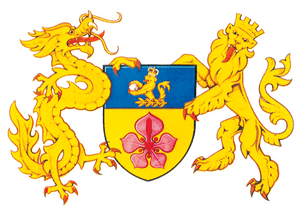
December 8, 1941
- The Empire of Japan invaded Hong Kong.
December 25, 1941
- The British gave up the territory to the Japanese Army.
August 1945
- Britain took back its territory after Japan surrendered.
1949
- Double-decker buses started running in Hong Kong.
1950
- Hong Kong became a free port for trade.
1953
- The Shek Kip Mei Estate started a public housing program.
1955
- A Han Tomb was found near Lei Cheng Uk.
1983
- The Hong Kong Dollar's value was fixed to the US dollar.
1984
- Britain and China signed the Sino-British Joint Declaration.
1990
- The Hong Kong Basic Law was approved.
1997
- Asia had a financial crisis.
- Archaeologists found 20 graves on Ma Wan.
July 1, 1997
- Hong Kong became a Special Administrative Region of China for 50 years.
1998
- Hong Kong International Airport opened. It replaced Kai Tak Airport.
June 2002
- Tung Chee Wa was elected as Chief Executive.
2003
- Citizens wanted a more democratic system.
- The SARS epidemic began.
March 10, 2005
- Tung Chee Wa retired as chief executive due to health.
March 2012
- Leung Chun Ying was elected as Chief Executive.
2014
- People protested in Central. They wanted to vote for their next chief executive in 2017.
2015
- The government voted against the people's demand for universal suffrage.
2016
- More protests happened in Mong Kok. Police used pepper spray to clear the area.
Hong Kong's Buildings
Hong Kong has 1,223 skyscrapers. This is the most in the world. It has more buildings taller than 150 meters than any other city. The city is very dense and has tall buildings because there isn't much space to build outwards. Much of the land is reclaimed from the sea. This lack of space means there is a high demand for tall offices and homes. Thirty-six of the world's 100 tallest homes are in Hong Kong. More people live or work above the 14th floor here than anywhere else. This makes it the world's most "vertical" city.
Because of the limited space, few old buildings remain. Hong Kong is now a center for modern architecture. The International Commerce Centre (ICC) is 484 meters (1,588 feet) high. It is the tallest building in Hong Kong. It is also the seventh tallest in the world. Before this, Tower 2 of the International Finance Centre was the tallest at 415 meters (1,362 feet). Other famous buildings include the HSBC Headquarters Building. There is also the triangular Central Plaza and The Center with its neon light show. I. M. Pei's Bank of China Tower has a sharp, angular design. A show called A Symphony of Lights happens daily. It uses the city's skyline as a backdrop. Many people think Hong Kong's skyline is the best in the world. The mountains and Victoria Harbour make the skyscrapers look even better. Some of the oldest buildings include the Tsim Sha Tsui Clock Tower. Also, the Central Police Station and parts of Kowloon Walled City were built in the 1800s and early 1900s.
Many new building plans are underway. These include new government buildings and waterfront projects. More tall buildings will be built in Kowloon. This is because the Kai Tak Airport closed in 1998. Its closure removed height limits for buildings nearby. The Urban Renewal Authority is tearing down old areas to rebuild them. This has been criticized for changing the city's culture. It also affects people with lower incomes.
City Views
Hong Kong's Economy
Hong Kong is a major center for global finance and trade. It has many company headquarters in the Asia-Pacific region.
Hong Kong is the world's seventh largest trading place for both exports and imports. The value of goods traded is more than its total economic output. It is also the world's largest transshipment center. This means many goods are made outside Hong Kong, especially in mainland China. Then they are sent through Hong Kong to other places. Its location has helped the city build a great transport system. This includes the world's second busiest container port. It also has the world's busiest airport for international cargo. Hong Kong's biggest export markets are mainland China and the United States.
Hong Kong has little farmland and few natural resources. So, it imports most of its food and raw materials. Imports make up over 90% of Hong Kong's food supply. This includes almost all of its meat and rice. Farming is not a big part of Hong Kong's economy. It only makes up 0.1% of its total output. Farmers mainly grow special food and flowers.
In the past, Hong Kong had a large manufacturing economy. This was in the second half of its time as a British colony. But now, Hong Kong's economy is mostly about services. Hong Kong was one of the Four Asian Tigers. It quickly became a manufacturing center after World War II. This was driven by exports. By the end of the colonial era, it was a developed high-income area. Between 1961 and 1997, Hong Kong's total economic output grew 180 times. The output per person grew 87 times.

Tourism is a big part of Hong Kong's economy. It makes up 5% of its total output. In 2016, 26.6 million visitors came to Hong Kong. They spent $32.9 billion. This made Hong Kong the 14th most popular place for international tourists. It is also the most popular city for tourists. It gets over 70% more visitors than Macau, its closest competitor. Hong Kong is also often ranked as one of the most expensive cities for people living abroad.
Getting Around Hong Kong
Hong Kong has a very good transport system. It includes both public and private ways to travel. The Transport Department manages all transport rules. Over 90% of daily trips are made using public transport. This is the highest percentage in the world. The Octopus card is a contactless smart payment card. It is used on trains, buses, and ferries. You can also use it in most shops. It started in 1997 on the Mass Transit Railway. It was the second contactless smart card system in the world. Now, it is used everywhere in Hong Kong.
Trains
The Mass Transit Railway (MTR) is a large train network. It connects 93 metro stations across Hong Kong. Over five million people use it every day. It serves 41% of all public transport users in the city. The trains are very on-time, reaching 99.9%. The train network covers inner Hong Kong, New Kowloon, Lantau Island, and parts of the New Territories. Nine train lines offer regular metro services. The Airport Express connects Hong Kong International Airport directly to the city center. A special line takes passengers to and from Hong Kong Disneyland.
You can take cross-border trains to Shenzhen on the East Rail Line. These trains stop at border checks at Lo Wu and Lok Ma Chau. Inter-city trains to Guangzhou, Shanghai, and Beijing leave from Hung Hom Station. A new train service to China's high-speed rail system was planned for 2018. This will happen after the West Kowloon Station is finished.
Roads and Taxis
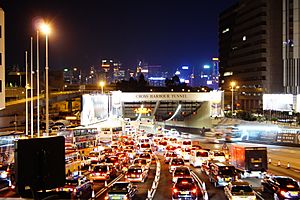
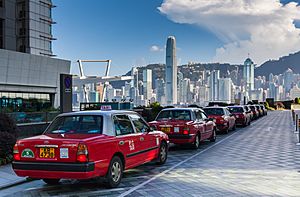
Cars in Hong Kong drive on the left. This is different from mainland China. It is because of British influence. Highways are part of the Hong Kong Strategic Route and Exit Number System. This system has three north-south routes and five east-west routes. It also includes the New Territories Circular Road. All major areas of Hong Kong are connected by this road system. Route 8 goes over the Tsing Ma Bridge. It connects the city center with Tsing Yi and Lantau Island. Routes 1, 2, and 3 go through three tunnels under Victoria Harbour. They connect Hong Kong Island with the Kowloon Peninsula. Route 10 offers direct road access to Shenzhen. It ends at the Shenzhen Bay Port. Hong Kong is connected to China's highway system at Lok Ma Chau. The G4 Beijing–Hong Kong–Macau Expressway ends at the Huanggang Port. It connects to Route 9 by a short road. The Hong Kong–Zhuhai–Macau Bridge will also connect Hong Kong to the mainland road system. It will create a direct route to the western side of the Pearl River estuary.
Public transport handles most passengers. But there are over 500,000 private cars in Hong Kong. Because Hong Kong is small, people are discouraged from owning private cars. Cars have a first-time registration tax. This tax can be from 35% to over 100% of the car's value. Also, over half the price of petrol is due to taxes. Road traffic is very busy during peak hours. Average car speeds can be as low as 10 km/h (6.2 mph) on main roads. Traffic jams are worse because of the city's layout. It is also hard to build more roads. The number of cars is also growing.
More than 18,000 taxis are allowed to operate in Hong Kong. They are easy to spot by their bright colors. Different colors mean different service areas. Red taxis serve Hong Kong Island, Kowloon, all of the New Territories, and northern Lantau Island. Green taxis work in parts of the New Territories. Blue taxis are only on Lantau Island.
Air Travel
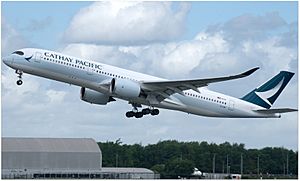
Hong Kong International Airport (HKG) is the main airport for Hong Kong. Over 100 airlines fly from this airport. It is the main base for flag carrier Cathay Pacific. It is also a hub for Cathay Dragon, Air Hong Kong, and Hong Kong Airlines. HKG is an important regional transfer center. It is a passenger hub and a gateway to mainland China and the rest of Asia. It also handles the most air cargo traffic in the world. Over 70 million passengers use it each year. This makes it the eighth busiest airport worldwide for passengers. HKG is built on an artificial island north of Lantau Island. It was built to replace the very crowded Kai Tak Airport in Kowloon Bay. Most private planes use Shek Kong Airfield in the New Territories. This is managed by the Hong Kong Aviation Club.
Ferries
The Star Ferry has been running since 1888. It has two lines across Victoria Harbour. It offers great views of Hong Kong's skyline. About 53,000 people use it every day. Ferries also go to outlying islands. These islands cannot be reached by other transport. Ferry companies include New World First Ferry, Hong Kong & Kowloon Ferry, and Tsui Wah Ferry. They also have routes to Macau and nearby cities in mainland China. This includes direct service between Hong Kong International Airport and Shenzhen Bao'an International Airport for connecting passengers. Cross-border services leave from the Macau Ferry Terminal, China Ferry Terminal, and Tuen Mun Ferry Pier.
Hong Kong is known for its junk ships. These traditional boats travel the harbor. Small kai-to ferries serve remote coastal villages.
Buses and Trams
Public bus services are run by five private companies. Together, they operate over 700 routes. The largest are Kowloon Motor Bus, with 402 routes in Kowloon and New Territories. Citybus runs 154 routes on Hong Kong Island. New World First Bus has 56 more routes in Kowloon and Hong Kong Island. All three major bus companies offer services across the harbor. They are a main way for 3.9 million daily bus passengers to travel. Double-decker buses started in Hong Kong in 1949. Now, they are much more common than single-decker buses. Single-decker buses are used for less busy routes or smaller roads. Smaller public light buses (also called minibuses) serve most parts of Hong Kong. They go to areas where regular buses cannot reach. Or they go where buses are less frequent, fast, or direct.
Hong Kong Island has steep, hilly land. It was first served by sedan chairs. The Peak Tram was Hong Kong's first public transport system. It has provided vertical rail transport between Central and Victoria Peak since 1888. In the Central and Western District, there is a large system of escalators and moving pavements. This includes the longest outdoor covered escalator system in the world, the Mid-Levels escalator. Hong Kong Tramways has served Hong Kong since 1904. It covers the northern parts of Hong Kong Island. The MTR also runs the Light Rail system. This serves the districts of Tuen Mun and Yuen Long.
Hong Kong's Culture
Hong Kong is often called a place where "East meets West". This shows how its Chinese roots mix with Western influences from its time as a British colony. Most people are ethnically Chinese. But the long period of British rule and Western culture has created a unique identity. Hong Kong's main culture comes from Chinese immigrants. But it is also shaped by British-style education, a different political system, and its role as a major trading port.
After World War II, Chinese immigrants helped Hong Kong's economy grow. This led to the idea that people could easily improve their lives. It also created a culture of entrepreneurialism and a strong work ethic among those who arrived. Many immigrants came from mainland China to escape hardship. So, people in Hong Kong often link their self-image and decisions to money and success.
Things like Ba gua mirrors are still used to keep away bad spirits. Buildings often skip the number 4 for floors. This is because "four" sounds like "die" in Cantonese. The mix of East and West also shows in Hong Kong's food. You can find dim sum, hot pot, and fast food restaurants next to fancy French restaurants.
Hong Kong is a global trade center. It also calls itself an "entertainment hub." Its martial arts films became very popular in the late 1960s and 1970s.
Hong Kong's Food
Food in Hong Kong is mostly based on Cantonese cuisine. This is true even with foreign influences and different people living there. Rice is the main food. It is usually served plain with other dishes. Fresh ingredients are very important. Poultry and seafood are often sold live at wet markets. Ingredients are used as quickly as possible. There are five meals each day: breakfast, lunch, afternoon tea, dinner, and siu yeh. Dim sum is part of yum cha (brunch). It is a tradition to eat out with family and friends. Dishes include congee, cha siu bao, siu yuk, egg tarts, and mango pudding. Local versions of Western food are served at cha chaan teng (Hong Kong-style cafes). Common cha chaan teng foods include macaroni in soup, deep-fried French toast, and Hong Kong-style milk tea.
Images for kids
-
Hong Kong in 1868, photographed by John Thomson
-
Hong Kong's population pyramid in 2016.
-
Wong Tai Sin Temple is for the Taoist god Wong Tai Sin.
-
The main building of the University of Hong Kong.
See also
 In Spanish: Hong Kong para niños
In Spanish: Hong Kong para niños




